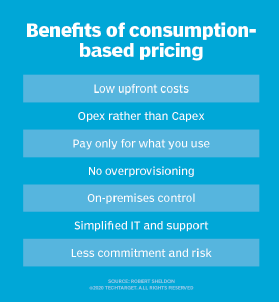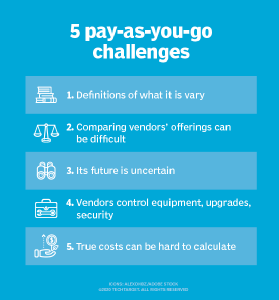Storage
- Editor's letterThese 5 IT buzzwords for 2021 reflect data storage priorities
- Cover storyThe best enterprise storage systems and products of 2020
- InfographicEfficient data storage tips to achieve a green data center
- FeatureEnterprise technology trends for 2021 shaped by COVID-19
- ColumnPay-per-use pricing model can boost digital initiatives
- ColumnCost-effective snapshot management tips and strategies

stock.adobe.com
Pay-per-use pricing model can boost digital initiatives
Consumption IT shifts the burden of infrastructure support to vendors and expenditures from Capex to Opex. Can pay-per-use pricing keep pace with your digital business roadmap?
Businesses of all shapes and sizes -- and across multiple industries -- are ramping up their digital business initiatives and IT services roadmaps. Even prior to COVID-19, these initiatives were high on the IT priority list, but in a soon-to-be post-coronavirus era (vaccine distribution permitting), businesses will succeed or fail based on their ability to use technology to better understand and engage with customers.
For some businesses, COVID-19 has reaffirmed their existing roadmaps and plans. For others, the pandemic has been a painful wake-up call. As businesses seek to add to or accelerate their digital initiatives, some would say transformations, personnel and budget constraints will present major hurdles to success.
Some IT organizations have turned to a pay-per-use or as-a-service model for infrastructure as a means of speeding up digital initiatives by accelerating investments without significantly impacting near-term budgets. Enterprise Strategy Group found in a recent study, for example, that IT organizations were more likely to favor a consumption-based model for procuring data center infrastructure over a traditional model with upfront capital purchases.
What's behind the growing interest in a pay-per-use pricing model?
Two high-level goals drive interest in consumption-based pricing: the need to simplify IT operations and a desire to maximize near-term budget opportunities.
A pay-per-use pricing model reduces the considerable level of effort involved with architecting and optimizing data center hardware for current and future needs of application environments. Given how quickly these environments are scaling and evolving -- especially with the rise of cloud-native, container-based workloads -- accurately forecasting infrastructure demands over multiple years has become increasingly difficult. In addition, more than one-third of IT organizations are experiencing problematic skill shortages in the area of IT architecture and planning. Shifting to a pay-per-use or as-a-service model can eliminate much, or all, of the upfront forecasting and architecting work.
The other, and possibly more enticing, benefit is that pay-per-use infrastructure purchasing offers a way to maximize the near-term potential of existing IT budgets. For enterprises that have multiple projects on the roadmap, shifting from a large upfront capital purchase model to one that allocates costs over the life of a technology can enable existing budgets to extend to a larger amount of infrastructure -- which can accelerate IT projects. This opportunity to accelerate activities with existing budgets has quickly become a major driver behind the increasing levels of interest in these consumption-based models.
What holds organizations back from consumption-based IT?
One of the more dominant reasons why organizations do not take advantage of as a service and pay per use is that their current budget model will not allow them. Another common critique, however, centers on the assumption that if you implement a pay-per-use model, you will pay more over time than if you procured the system upfront. In other words, usage-based pricing enables you to pay less upfront, but over the life of the product, those who choose to pay more upfront will pay less overall.

Each offering is different. But even if you assume that a pay-per-use option would require a larger expense versus an upfront purchase, the ability to defer payments has value. In addition, pay-per-use models reduce the personnel, time and risk associated with forecasting the environment.
The cost equation ultimately comes down to two questions: How confident are you with your ability to forecast application needs over the next three to four years? And are you sure there isn't something you could do that would be a better use of your time?
As-a-service vs. consumption-based pricing
The research data on the rising interest in a pay-per-use pricing model often focuses predominately on consumption-based pricing, which is different from a true as-a-service model. Organizations can achieve similar benefits with each approach, however.
With subscription-based pricing, you manage the infrastructure, but only pay for what you use. With an as-a-service model, the expectation is that the infrastructure vendor will take care of the maintenance, support and even the upgrade path. As a service goes further to reduce the burden on IT resources, which can help accelerate digital initiatives.
What pay-per-use means to your organization
If you are not already evaluating consumption-based pricing or as-a-service options, now is the time to start.

Often, beginning this process starts at the executive level with finance buy-in. Nearly every data center storage or infrastructure provider offers a consumption-based payment option or an as-a-service option, including Dell Technologies, Hewlett Packard Enterprise, Hitachi Vantara, IBM, Lenovo, NetApp, Nutanix and Pure Storage. Chances are your existing vendor is already discussing it with you.
If you have resisted the idea of a pay-per-use or as-a-service model in the past, keep an open mind. These models can enable you to do more with the budget you have. The question is not whether you understand your application environment better than a provider would. You may, in fact, be able to forecast your technical demands better than any storage vendor can. The question to ask is: "If I offloaded that work, what else could I accomplish? Would that reclaimed time help me accelerate my business's digital needs?"
Scott Sinclair is a senior analyst at Enterprise Strategy Group (ESG), which is a division of TechTarget.




























